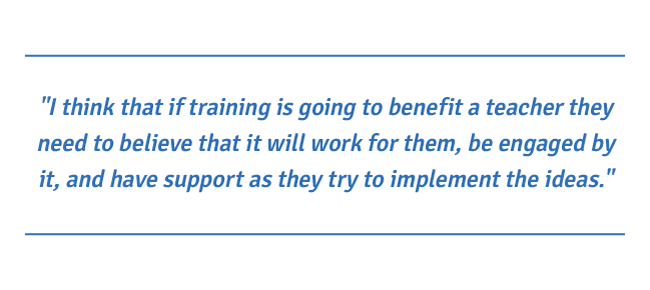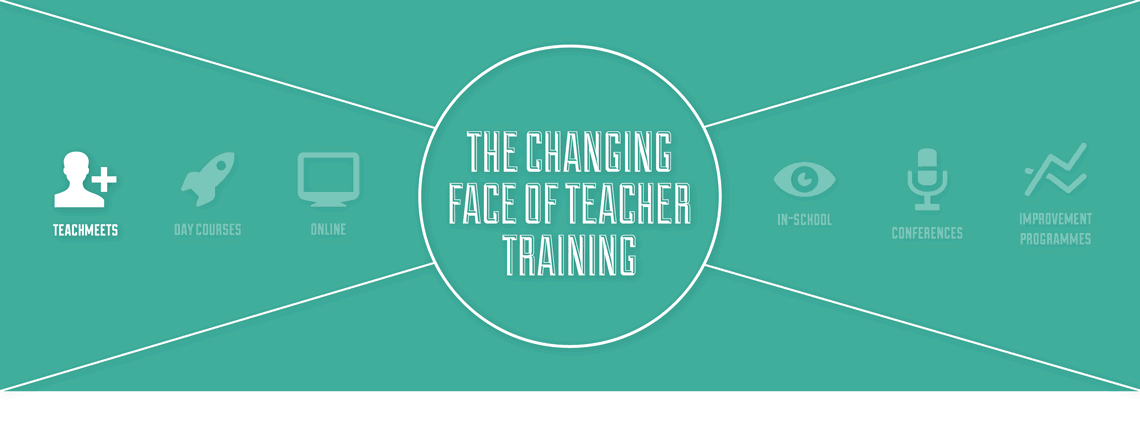Andy talks to Staffroom about how the ways in which teachers are trained and developed have changed, and speculates on how training might look in the future.
Andy has been training teachers for fifteen years, and in that time has created and presented many courses. Andy’s courses have helped schools to be recognised in the TES awards and to improve in Ofsted terms, and he has won a national training award. So…
How has the training of teachers changed over recent years?
I joined the teaching profession in 1989, then fifteen years ago I left full-time teaching to become a part-time teacher and trainer. Since my time in education, there has been a growth in both external training (by companies and freelance individuals) and internal training (where colleagues lead CPD (continuing professional development) for others).
We have to remember that the first INSET days only go back to 1988 when they were referred to as ‘Baker Days’, after the then Education Secretary, Kenneth Baker. Also, Ofsted opened up shop in 1992, which has put more pressure on schools to improve.

In the years of the Labour government (1997–2010), education funding was prioritised. Tony Blair’s ‘Education, education, education’ speech ensured that our industry was given funding priorities. This, in part, raised the demand for training and consultancy services. However, in recent years there has been a decline in the influence of local authorities and the advisors that worked for them.
If you ask teachers who have been in the classroom for over thirty years they will tell you that, in the early part of their careers, there were very few opportunities to access training courses. Now, subject to budget, school priorities and being ‘allowed out’, the array of training choices is immense. Of course, all of this growth doesn’t guarantee high-quality training, but I do feel that there are some exceptional learning opportunities out there for teachers that simply weren’t there years ago. There are lots of models of training too.
What do you mean by ‘models’ of training?
When I first started running training courses, they were all of one ‘type’ or ‘model’ — the ‘one-day hit’. They still form about a quarter of my diary, and can be very effective in their own right. These take the form of INSET days or CPD events.
Over the past eight years I’ve increasingly been devising and leading modular courses. These courses are longer in duration, thereby allowing the people on them more time to address and change their habits, attitudes and skills (and those of the colleagues they are teaching or leading).
Courses such as the Outstanding Teaching Intervention (OTI) and Leading Outstanding Teaching, Learning and Assessment (LOTLA) involve elements of doing, going away, doing, reporting back, and adapting. What goes on between the modules is of great significance, and without this structure the trainer would never know the learning or challenges that are taking place for the course member.
A lot more internal training also seems to be modular in nature. Two teaching schools that I have associations with, St John Bosco Arts College in Liverpool, and Sandringham School in St Albans, both run internal CPD that requires staff to do more than simply attend a session.
Teachers are required to go away and try things out, and report on their learning to colleagues. This includes videoing themselves teach, leading action research projects, developing collaborative planning strategies, and team teaching. The pressure to do something or try something from the training session has, in those two Outstanding schools, helped to create excellent learning cultures among the teachers.
Conversely, some aspects of training have become shorter than the full day experience. For instance, ‘Teachmeets’ have been a welcome innovation over the past few years. Here, presentations can often be very short (three- or five-minute) spots where a teacher will share an idea or innovation with the rest of the group. Recent years have seen the emergence of a real diversity of models of training.
What does the future of teacher training hold?
When I started my career, e-learning was something that only happened in Yorkshire! With the advent of new technologies, I would expect more training to take place online (such as webinars and in virtual environments). I’ve just run my first INSET day where all the audience, and people outside the room, were accessing the resources and feeding back their thoughts using tablet computers. I expect more of this over the coming years.
It’s great to see more teaching schools, and possibly separate research schools, emerging. There is strong healthy debate around evidence-based research, and our industry certainly seems to be way past the era of advocating educational quackery such as brain gym and learning styles. We’re much more into ‘what makes the most impact on learners’ nowadays – although some of us have always evaluated both teaching quality and training quality in those terms.
My hope is that in the future teachers will receive more accreditation from attending and leading training. I’d like to see universities being more flexible in how they link with schools and colleges so we could see more teachers attaining masters’ degrees and even PHDs while teaching.
Hopefully, the new College of Teachers will work with universities to enable the development of accredited courses for those attending and leading the training. I’d also like to see more scepticism from teachers towards outside experts, combined with better internal CPD led by teachers who have earned the right to train others through a proven track record of effectiveness.
Why do you want to see more sceptical teachers?
I think scepticism is a healthy intellectual position to take when accessing training. This is distinctly different from cynicism, of course. I think that if training is going to benefit a teacher they need to believe that it will work for them, be engaged by it, and have support as they try to implement the ideas.
An unthinking deference to ‘experts’ (which is how I am sometimes described) can stop teachers thinking for themselves. I hope that teachers are still open to learning from non-teachers too, as the cross-fertilisation of ideas from other fields can help develop more creative thinking.
Can you give an example of that?
I’ve always been interested in issues around motivation. Learning about cognitive behaviour therapy (CBT), Gestalt analysis and the Alexander technique are just three areas that have helped me to rethink how I operate, and when I teach or train. I certainly wouldn’t want to be closed to any type of learning that might make me a more effective teacher or trainer.
What do you think the training of teachers might look like fifteen years from now?
Well, for one thing there will still be lots of training, because the vast majority of teachers want to do a good job and want to keep learning throughout their careers. High-quality training gives people clarity about how to be more effective. As Brian Tracy puts it in his time management book, Eat That Frog!: “Some people are doing better than others because they do things differently and they do the right things right.1â€
I would expect there to be more e-learning training opportunities, even greater access to videos of teachers exemplifying effective classroom practice (which Doug Lemov has done to good effect), and hopefully the teaching profession will have more access to learning how master teachers operate — Professor John Hattie urges us to build a coalition around the successful.
In our latest book, Teaching Backwards, we unpick some of those traits, as does Hattie himself in his work on Visible Learning. It would be great to see novice teachers learning the right things from the right people at the outset of their careers rather than muddle through. I was fortunate in the early part of my career to work under two great heads of department, Bill Rimmer and Ian Macleod, from whom I learned so much. They put me on the right track — but I was one of the lucky ones.
Despite all the advances in technology, exciting as some of them are, there will always be a place for the human interaction of training others. There are still lots of people who need to have rapport with a person as a prerequisite for learning anything from them, so I predict there will still be lots of face-to-face training.
Whether there will be so much training on offer in future, I’m really not sure. The next election may produce a government that no longer ring-fences education as a spending priority. This would cut school budgets and, in so doing, reduce the flexibility of schools to release teachers for training and force schools to give teachers heavier teaching loads, which means less time to be able to do research and development work. So vote carefully! SR


